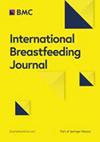国家带薪家事假政策与母乳喂养持续时间:对 2021 年全国免疫接种调查--儿童的横断面分析
IF 2.9
2区 医学
Q1 OBSTETRICS & GYNECOLOGY
引用次数: 0
摘要
带薪育儿假政策可促进母乳喂养,这对分娩者-婴儿二人组中的双方都有短期和长期的健康益处。在美国,56% 的劳动力有资格享受无薪联邦医疗假,某些州最近颁布了带薪育儿假和家事假政策。我们的目的是评估生活在有带薪家事假的州和没有带薪家事假的州在多大程度上与包括母乳喂养在内的喂养方式有关。在这项对 2021 年全国免疫接种调查--儿童的横断面分析中,我们评估了以下喂养结果:(1)纯母乳喂养(只喂母乳,不喂婴儿配方奶粉--6 个月大之前和之后);(2)晚期混合母乳喂养(6 个月后喂配方奶粉);(3)早期混合母乳喂养(6 个月前喂母乳和配方奶粉);(4)从不喂母乳。我们通过 Pearson χ2 比较了社会人口学特征,并通过多变量名义回归评估了带薪家事假与母乳喂养方式的相关程度,并与从未进行母乳喂养进行了比较。在 35,995 位受访者中,5,806 位(占加权受访者的 25%)来自实行带薪家事假政策的州。与从不进行母乳喂养相比,所有包含母乳喂养的喂养方式--纯母乳喂养、晚期混合喂养(母乳喂养,6 个月后添加配方奶粉)和早期混合喂养(母乳喂养,6 个月前添加配方奶粉)--在实行带薪家事假政策的州更为普遍。在实行带薪家事假政策的州与未实行带薪家事假政策的州,调整后的流行率(aPR)以及调整后的流行率与从不母乳喂养相比的差异为:纯母乳喂养的调整后流行率为 1.41(95% CI 1.15,1.73),差异为 5.36%;晚期混合喂养的调整后流行率为 1.25(95% CI 1.01,1.53),差异为 3.19%;早期混合喂养的调整后流行率为 1.32(95% CI 1.32,1.97),差异为 5.42%。实行带薪家事假政策的州的任何母乳喂养率和纯母乳喂养率均高于未实行此类政策的州。由于在实行带薪家事假政策的州,所有包含母乳喂养的喂养类型都更高,因此扩大带薪家事假可能会提高母乳喂养率。本文章由计算机程序翻译,如有差异,请以英文原文为准。
State paid family leave policies and breastfeeding duration: cross-sectional analysis of 2021 national immunization survey-child
Paid parental leave policies may promote breastfeeding, which can have short- and long-term health benefits for both members of the birthing person-infant dyad. In the United States, where 56% of the workforce qualifies for unpaid federal medical leave, certain states have recently enacted paid parental and family leave policies. We aimed to assess the extent to which living in states with versus without paid family leave was associated with feeding regimens that included breastfeeding. In this cross-sectional analysis of the 2021 National Immunization Survey-Child, we assessed feeding outcomes: (1) exclusively breastfed (only fed breastmilk—never infant formula—both before and after six months of age), (2) late mixed breastfeeding (formula after six months), (3) early mixed breastfeeding (breastfed, formula before six months), and (4) never breastfed. We conducted Pearson χ2 to compare social-demographic characteristics and multivariable nominal regression to assess extent to paid family leave was associated with breastfeeding regimens, compared with never breastfeeding. Of the 35,995 respondents, 5,806 (25% of weighted respondents) were from states with paid family leave policies. Compared with never breastfeeding, all feeding that incorporated breastfeeding—exclusive breastfeeding, late mixed feeding (breastfed, formula introduced after six months), and early mixed feeding (breastfed, formula introduced before six months)—were more prevalent in states with paid family leave policies. The adjusted prevalence ratio (aPR) and differences in adjusted prevalence compared with never breastfeeding in states with versus without paid family leave policies were: aPR 1.41 (95% CI 1.15, 1.73), 5.36% difference for exclusive breastfeeding; aPR 1.25 (95% CI 1.01, 1.53), 3.19% difference for late mixed feeding, aPR 1.32 (95% CI 1.32, 1.97), 5.42% difference for early mixed feeding. States with paid family leave policies have higher rates of any breastfeeding and of exclusive breastfeeding than states without such policies. Because all feeding types that incorporate breastfeeding were higher in states with paid family leave policies, expansion of paid family leave may improve breastfeeding rates.
求助全文
通过发布文献求助,成功后即可免费获取论文全文。
去求助
来源期刊

International Breastfeeding Journal
Medicine-Obstetrics and Gynecology
CiteScore
6.30
自引率
11.40%
发文量
76
审稿时长
32 weeks
期刊介绍:
Breastfeeding is recognized as an important public health issue with enormous social and economic implications. Infants who do not receive breast milk are likely to experience poorer health outcomes than breastfed infants; mothers who do not breastfeed increase their own health risks.
Publications on the topic of breastfeeding are wide ranging. Articles about breastfeeding are currently published journals focused on nursing, midwifery, paediatric, obstetric, family medicine, public health, immunology, physiology, sociology and many other topics. In addition, electronic publishing allows fast publication time for authors and Open Access ensures the journal is easily accessible to readers.
 求助内容:
求助内容: 应助结果提醒方式:
应助结果提醒方式:


